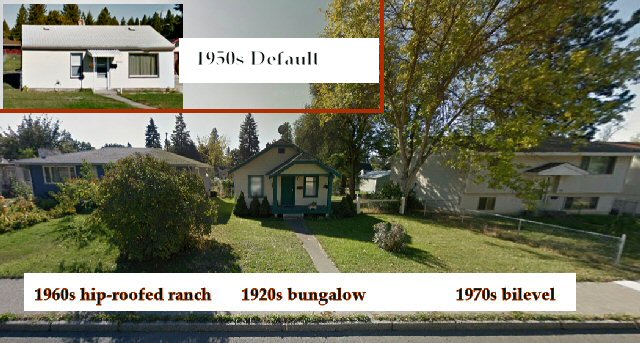Sunday, January 03, 2016
Relevant observation
As I walk and bus around, I'm observing icicles and ice dams. I started with hypotheses that steep roofs should be better and newer houses should be better. Nope. Shape and age are IRRELEVANT.
Even the steepest roofs and the newest houses can form ice dams. Some metal roofs have icicles, but on a metal roof it doesn't matter because there's no way for the water to force its way through the membrane.
In this neighborhood there are 4 standard and repeated house types, along with many nonstandard oddities. The 1920s bungalow, the 1950s Default Spokane House, the 1960s hip-roofed rancher, and the 1970s bilevel.
 Each of these standard types was built by one contractor within a limited interval of years, and each has only a few variations. Despite that, each type has a full range of icicularity. You can find near-zero icicles and thousands of icicles within each category.
There are two new houses, built by the same contractor about two years ago, nearly identical. The first has lots of icicles and the second has none. In this case the difference is no mystery. The second house was raked.
Obvious answer, aside from raking: It's all about the insulation. Clearly some houses have been refitted with the best insulation. Which is best? Dunno.
= = = = =
Sidenote: The equation also has an opposite solution, like the imaginary root of a quadratic. A few of the oldest and least maintained houses have perfectly dry roofs except for a narrow edge. Clearly these houses have very little insulation. The roof evaporates snow instantly. I'm assuming these folks pay a hefty heating bill, but that assumption could be wrong, like most of my assumptions. This could be the ideal compromise.
Each of these standard types was built by one contractor within a limited interval of years, and each has only a few variations. Despite that, each type has a full range of icicularity. You can find near-zero icicles and thousands of icicles within each category.
There are two new houses, built by the same contractor about two years ago, nearly identical. The first has lots of icicles and the second has none. In this case the difference is no mystery. The second house was raked.
Obvious answer, aside from raking: It's all about the insulation. Clearly some houses have been refitted with the best insulation. Which is best? Dunno.
= = = = =
Sidenote: The equation also has an opposite solution, like the imaginary root of a quadratic. A few of the oldest and least maintained houses have perfectly dry roofs except for a narrow edge. Clearly these houses have very little insulation. The roof evaporates snow instantly. I'm assuming these folks pay a hefty heating bill, but that assumption could be wrong, like most of my assumptions. This could be the ideal compromise.
 Each of these standard types was built by one contractor within a limited interval of years, and each has only a few variations. Despite that, each type has a full range of icicularity. You can find near-zero icicles and thousands of icicles within each category.
There are two new houses, built by the same contractor about two years ago, nearly identical. The first has lots of icicles and the second has none. In this case the difference is no mystery. The second house was raked.
Obvious answer, aside from raking: It's all about the insulation. Clearly some houses have been refitted with the best insulation. Which is best? Dunno.
= = = = =
Sidenote: The equation also has an opposite solution, like the imaginary root of a quadratic. A few of the oldest and least maintained houses have perfectly dry roofs except for a narrow edge. Clearly these houses have very little insulation. The roof evaporates snow instantly. I'm assuming these folks pay a hefty heating bill, but that assumption could be wrong, like most of my assumptions. This could be the ideal compromise.
Each of these standard types was built by one contractor within a limited interval of years, and each has only a few variations. Despite that, each type has a full range of icicularity. You can find near-zero icicles and thousands of icicles within each category.
There are two new houses, built by the same contractor about two years ago, nearly identical. The first has lots of icicles and the second has none. In this case the difference is no mystery. The second house was raked.
Obvious answer, aside from raking: It's all about the insulation. Clearly some houses have been refitted with the best insulation. Which is best? Dunno.
= = = = =
Sidenote: The equation also has an opposite solution, like the imaginary root of a quadratic. A few of the oldest and least maintained houses have perfectly dry roofs except for a narrow edge. Clearly these houses have very little insulation. The roof evaporates snow instantly. I'm assuming these folks pay a hefty heating bill, but that assumption could be wrong, like most of my assumptions. This could be the ideal compromise.
Labels: infill
